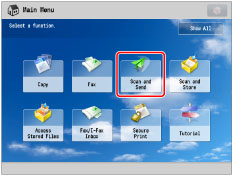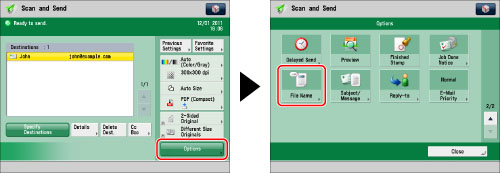 e-Manual e-Manual | Top Site map Site map Help Help Glossary Glossary |
|---|---|
 Category Top
Category Top What This Machine Can Do
What This Machine Can Do Overview of This Function
Overview of This Function Things You Must Do Before Using This Machine
Things You Must Do Before Using This Machine Flow of Sending Operations
Flow of Sending Operations Canceling a Job
Canceling a Job Specifying Destinations
Specifying Destinations Specifying Destinations Using the Address Book (Local)
Specifying Destinations Using the Address Book (Local) Specifying Destinations Using the Address Book (Remote)
Specifying Destinations Using the Address Book (Remote) Specifying Destinations Using the Address Book (LDAP Server)
Specifying Destinations Using the Address Book (LDAP Server) Specifying Destinations Using the One-Touch Buttons
Specifying Destinations Using the One-Touch Buttons Specifying a Destination by Entering an E-mail Address
Specifying a Destination by Entering an E-mail Address Specifying Destinations by Entering an I-Fax Address
Specifying Destinations by Entering an I-Fax Address Specifying a Destination by Entering a File Server
Specifying a Destination by Entering a File Server Specifying a File Server Using the Keyboard
Specifying a File Server Using the Keyboard Specifying a File Server Using the Browse Key (Windows (SMB))
Specifying a File Server Using the Browse Key (Windows (SMB)) Specifying a File Server Using the Search Host Key (Windows (SMB))
Specifying a File Server Using the Search Host Key (Windows (SMB)) Storing in a Mail Box
Storing in a Mail Box Storing in an Advanced Box
Storing in an Advanced Box Setting Your Personal Folder as the Destination
Setting Your Personal Folder as the Destination Setting Your Own E-Mail Address as the Destination
Setting Your Own E-Mail Address as the Destination Setting Cc and Bcc Addresses
Setting Cc and Bcc Addresses Checking/Editing/Deleting the Information for a Destination
Checking/Editing/Deleting the Information for a Destination Favorite Settings
Favorite Settings Recalling Previous Send Jobs
Recalling Previous Send Jobs Storing New Addresses
Storing New Addresses Registering an E-Mail Address
Registering an E-Mail Address Registering an I-Fax Address
Registering an I-Fax Address Registering a File Server Address
Registering a File Server Address Registering a Group Address
Registering a Group Address Registering an Address Obtained via an LDAP Server
Registering an Address Obtained via an LDAP Server Registering an Advanced Box Address
Registering an Advanced Box Address Storing/Editing/Deleting One-Touch Buttons
Storing/Editing/Deleting One-Touch Buttons Checking/Editing/Deleting a Stored Address
Checking/Editing/Deleting a Stored Address Registering/Editing/Deleting Favorite Settings
Registering/Editing/Deleting Favorite Settings Registering/Editing Favorite Settings
Registering/Editing Favorite Settings Checking Favorite Settings
Checking Favorite Settings Editing a Name/Comment
Editing a Name/Comment Deleting Favorite Settings
Deleting Favorite Settings Assigning Shortcuts
Assigning Shortcuts Switching the Color Mode
Switching the Color Mode Setting the Resolution
Setting the Resolution Specifying/Registering Scan Sizes
Specifying/Registering Scan Sizes Setting the File Format
Setting the File Format Trace and Smooth
Trace and Smooth Compact PDF or XPS
Compact PDF or XPS Searchable PDF/XPS/OOXML
Searchable PDF/XPS/OOXML Adding a Digital Signature to a PDF or XPS
Adding a Digital Signature to a PDF or XPS Encrypting PDF Files
Encrypting PDF Files Reader Extensions
Reader Extensions Applying a Policy
Applying a Policy Selecting the Original Type
Selecting the Original Type 2-Sided Original
2-Sided Original Book → 2 Pages
Book → 2 Pages Different Size Originals
Different Size Originals Adjusting Density Manually
Adjusting Density Manually Adjusting Background Density
Adjusting Background Density Adjusting the Image Sharpness
Adjusting the Image Sharpness Changing the Zoom Ratio
Changing the Zoom Ratio Erase Frame
Erase Frame Job Build
Job Build Delayed Send
Delayed Send Preview
Preview Finished Stamp
Finished Stamp Job Done Notice
Job Done Notice File Name
File Name Subject/Message
Subject/Message Reply-to
Reply-to Setting E-Mail Priority
Setting E-Mail Priority Receiving I-Fax Documents
Receiving I-Fax Documents Processing Received Documents
Processing Received Documents Receiving Documents
Receiving Documents Setting the Memory Lock Mode
Setting the Memory Lock Mode Forwarding Received Documents
Forwarding Received Documents Available Paper Sizes
Available Paper Sizes When Problems Occur
When Problems Occur Questions & Answers
Questions & Answers

|
IMPORTANT
|
|
The desired text block may not be set as the file name depending on the layout of the document, etc.
Characters, such as commas (,), slashes (/), or brackets ([,]) are invalid when sending a file and will not be extracted as the file name.
If you have already entered a document name, the extracted text block is appended to the end of the file name. Characters over the character limit will be cut off.
You cannot set the encrypted PDF mode and [Auto (OCR)] at the same time.
|
|
NOTE
|
|
When you send documents via e-mail or I-fax, each page is sent as a separate image attached to an e-mail message or a separate TIFF image attached to an I-fax. The file extension for the document matches the file format that you select for sending. The file name is assigned as follows:
If you set the file name:
The file name is composed of the file name as entered, plus three digits that represent the page number of the image. Example: file name_002.tif If you do not set the file name:
The file name is composed of the job number (0001 to 4999), plus three digits that represent the page number of the image. Example: 1231_002.tif When you send documents to a file server, each page is sent and stored as a separate image. The file extension for the document matches the file format that you select for sending. The file name is assigned as follows:
If you set the file name:
If you Divide into Pages: The file name is composed of the file name as entered, the year, month, day, hour, minute, and second the file is sent, and five digits that represent the page number of the image. Examples: file name_20120707203000_00002.tif file name_20120707203000_00002.jpg file name_20120707203000_00002.pdf file name_20120707203000_00002.xps If you do not Divide into Pages: The file name prefix is generated by the file name and the year, month, day, hour, minute, and second the file is sent. Examples: file name_20120707203000.tif file name_20120707203000.pdf file name_20120707203000.xps If you do not set the file name:
If you Divide into Pages: The file name prefix is generated by the year, month, day, hour, minute, and second the file is sent, and the five digits that signify the page number of the image. Examples: 20120707203000_00002.tif 20120707203000_00002.jpg 20120707203000_00002.pdf 20120707203000_00002.xps If you do not Divide into Pages: The file name is composed of the year, month, day, hour, minute, and second the file is sent. Examples: 20120707203000.tif 20120707203000.pdf 20120707203000.xps You can specify a file name using the Remote UI when sending to an e-mail/I-fax address or a server that is stored in [Favorite Settings]. (See "Specifying a File Name for Transmission to a Destination in Favorite Settings.")
|
|
IMPORTANT
|
|
If you use characters such as backslashes (\), slashes (/), colons (:), asterisks (*), question marks (?), double quotation marks ("), open angle brackets (<), close angle brackets (>), and vertical bars (|) in the document name, you are unable to send the file to file servers that run on operating systems that do not recognize such characters.
|